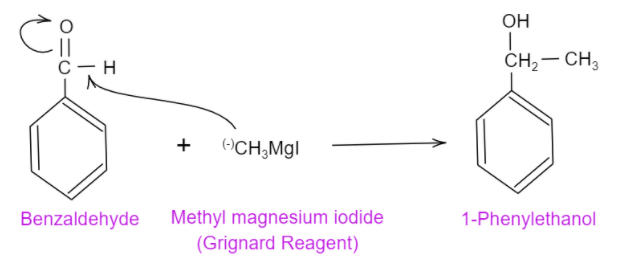
A. Methyl bromide
B. Ethyl iodide and magnesium
C. Methyl iodide and magnesium
D. Methyl bromide and aluminium bromide
Answer
487.5k+ views
Hint: Keep in mind that, when a carbonyl (i.e. an aldehyde or ketone) is treated with the Grignard reagent, the reactants will undergo Grignard reaction and will produce a secondary or tertiary alcohol. So, here benzaldehyde is given which is an aldehyde.
Complete step by step solution:
Given that,
Here, benzaldehyde is a carbonyl i.e. it is an aldehyde and has a chemical formula,
So, we should have knowledge that whenever a carbonyl is given in the reactant and in product alcohol is formed, Grignard reagent (
So, here methyl bromide when treated with benzaldehyde cannot form alcohol as it is not a Grignard reagent and there is an absence of highly electropositive magnesium which generally makes methyl group negative. But here the methyl group is positive and it cannot attack the carbonyl carbon.
Moving forward to ethyl iodide and magnesium, ethyl iodide is a two-carbon containing alkyl group. So, it will not form
In case of methyl iodide and magnesium, it is a one-carbon containing alkyl group and it has magnesium in it which will make the methyl group negative. This negative methyl group will attack on the positive carbon present in the carbonyl group and will form an alcohol. The following chemical reaction is shown:

In case of methyl bromide and aluminium bromide, the aluminium bromide will attract the bromine towards itself making the methyl group positive. So, here also the positive methyl group will not attack the positive carbon on the carbonyl group and will not yield alcohol.
Hence, the correct option is C.
Note: Possibly you may get confused with the option B, where ethyl iodide and magnesium are given. It is important to note that ethyl iodide has a two-carbon alkyl group. Thus, it will yield propanol when reacted with benzaldehyde instead of ethanol.
Complete step by step solution:
Given that,
Here, benzaldehyde is a carbonyl i.e. it is an aldehyde and has a chemical formula,
So, we should have knowledge that whenever a carbonyl is given in the reactant and in product alcohol is formed, Grignard reagent (
So, here methyl bromide when treated with benzaldehyde cannot form alcohol as it is not a Grignard reagent and there is an absence of highly electropositive magnesium which generally makes methyl group negative. But here the methyl group is positive and it cannot attack the carbonyl carbon.
Moving forward to ethyl iodide and magnesium, ethyl iodide is a two-carbon containing alkyl group. So, it will not form
In case of methyl iodide and magnesium, it is a one-carbon containing alkyl group and it has magnesium in it which will make the methyl group negative. This negative methyl group will attack on the positive carbon present in the carbonyl group and will form an alcohol. The following chemical reaction is shown:

In case of methyl bromide and aluminium bromide, the aluminium bromide will attract the bromine towards itself making the methyl group positive. So, here also the positive methyl group will not attack the positive carbon on the carbonyl group and will not yield alcohol.
Hence, the correct option is C.
Note: Possibly you may get confused with the option B, where ethyl iodide and magnesium are given. It is important to note that ethyl iodide has a two-carbon alkyl group. Thus, it will yield propanol when reacted with benzaldehyde instead of ethanol.
Recently Updated Pages
Master Class 4 Maths: Engaging Questions & Answers for Success

Master Class 4 English: Engaging Questions & Answers for Success

Master Class 4 Science: Engaging Questions & Answers for Success

Class 4 Question and Answer - Your Ultimate Solutions Guide

Master Class 11 Economics: Engaging Questions & Answers for Success

Master Class 11 Business Studies: Engaging Questions & Answers for Success

Trending doubts
Give 10 examples of unisexual and bisexual flowers

Draw a labelled sketch of the human eye class 12 physics CBSE

Differentiate between homogeneous and heterogeneous class 12 chemistry CBSE

a Tabulate the differences in the characteristics of class 12 chemistry CBSE

Why is the cell called the structural and functional class 12 biology CBSE

Differentiate between insitu conservation and exsitu class 12 biology CBSE




